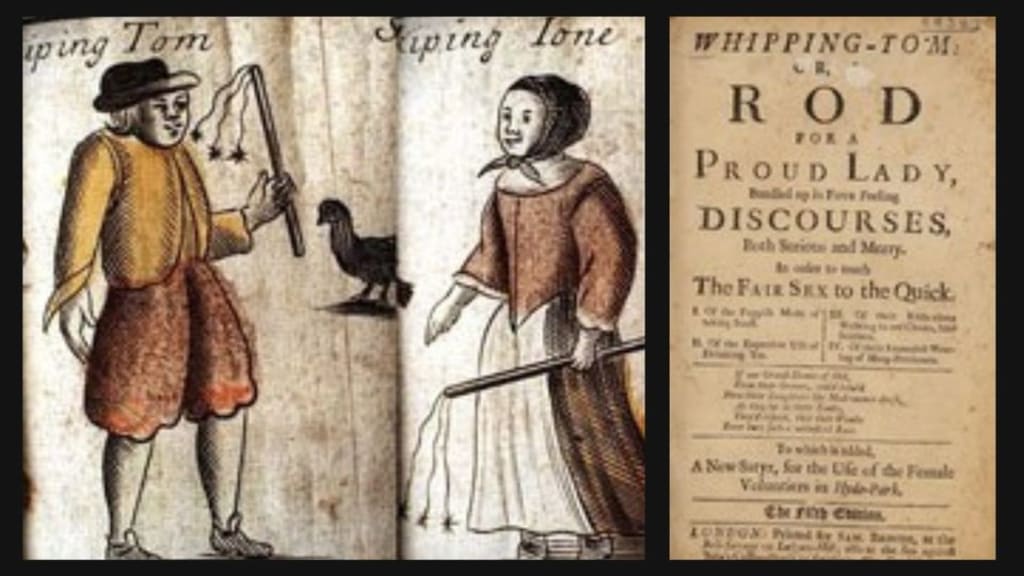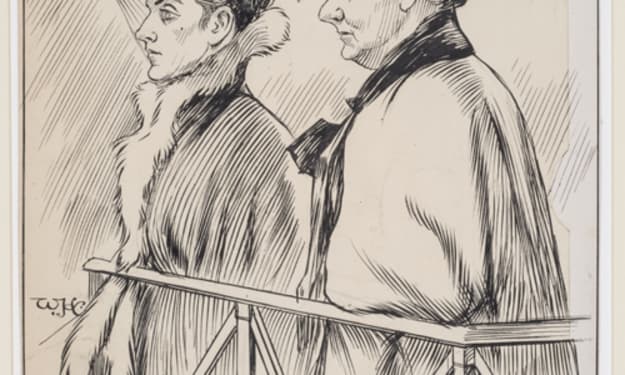Whipping Tom
The Mysterious Serial Spanker of 17th Century London

Introduction
The dark, streets of 17th-century London have borne witness to countless tales of crime, intrigue, and enigma. While the city is often associated with notorious figures like Jack the Ripper, it was plagued by a peculiar and lesser-known menace – Whipping Tom. Operating in the late 1600s, Whipping Tom embarked on a reign of terror that left women in fear and the public bewildered. This enigmatic attacker would grab unsuspecting women, lift their dresses, and deliver a stinging spank to their buttocks, all while bellowing, "Spanko!" Before Jack the Ripper's infamous deeds in the 19th century, Whipping Tom was London's own serial spanker, and this article delves into the bizarre tale of this peculiar figure.
The Enigmatic Whipping Tom
The legend of Whipping Tom, also known as the "enemy of Milk-wenches' bums," traces back to the 1670s. He had no specific target, indiscriminately choosing female victims of all ages, shapes, and social distinctions. The attacker was a man dressed in black who would deliver sudden spanks to the buttocks of his unsuspecting victims, following it up with the victorious cry of "Spanko!"
Despite the fear and discomfort he caused, Whipping Tom managed to evade capture, perpetuating the mystery. As reports of his bizarre attacks spread, Londoners became increasingly concerned, particularly women who dared not venture out after dusk without carrying weapons like penknives and scissors. Some gallant men even donned women's clothing, patrolling areas where Whipping Tom was known to strike.
But who was this strange assailant, and what motivated his odd crimes? Speculation about his identity and motives adds to the intrigue surrounding this peculiar case. There were even suggestions at the time of a supernatural element behind Whipping Tom.
Public Outcry and Vigilantism
The relentless attacks by Whipping Tom triggered a public outcry and raised questions about the effectiveness of London's policing in the late 17th century. Women, worried for their safety, took matters into their own hands, arming themselves with whatever sharp objects they could carry. Meanwhile, male vigilantes patrolled in disguise, hoping to unmask this elusive assailant.
As fear swept through the streets of London, Whipping Tom's crimes became emblematic of the broader societal concerns about crime and disorder in the city. These assaults reflected a pervasive anxiety, prompting collective action and discussions about public safety.
The Capture and Lost Records
Eventually, the reign of Whipping Tom came to an end when two individuals, a local haberdasher, and an accomplice were apprehended. Unfortunately, the records of their trial have been lost to history, leaving the public with a lingering sense of doubt and curiosity about the true identity of Whipping Tom and the justice he faced.
The loss of these records invites speculation about what might have transpired during the trial and whether the punishments were fitting for the peculiar nature of the crimes. The absence of these crucial historical documents only deepens the mystery of Whipping Tom's saga.
A Copycat Emerged in 1712
While Whipping Tom's reign of bizarre spankings concluded, history would not forget this peculiar figure. In 1712, a copycat assailant emerged, also referred to as Whipping Tom. He targeted women in the countryside, employing a birch rod as his weapon of choice. His spankings, however, were short-lived as he was eventually captured. This copycat, later identified as Thomas Wallis, confessed to the attacks, leaving a trail of odd and perplexing crimes that echoed the legacy of the original Whipping Tom.
Comparing and contrasting the actions of the original Whipping Tom with this copycat figure reveals both the unique and recurring aspects of these peculiar cases. The emergence of a copycat raises questions about the impact and influence of the enigmatic Whipping Tom on subsequent bizarre criminals.
Unpacking the Historical Accounts
To fully comprehend the historical significance of Whipping Tom's case, it is essential to examine the attitudes, language, and perceptions of crime in the 17th century. While the accounts of his actions may seem peculiar and humorous to modern readers, they were taken very seriously at the time. In the 17th century, terms like "pranks" had a more ominous connotation, describing evil deeds rather than mere jests.
The historical accounts also shed light on the public's response to Whipping Tom's actions. Fear and anxiety among women prompted them to arm themselves, while male vigilantes attempted to capture the assailant. The portrayal of Whipping Tom as an otherworldly spirit reflects the deep mystique and perplexity surrounding his crimes.
The Modern Lens
The story of Whipping Tom continues to captivate the imagination, transcending the centuries. The peculiar case, once a source of fear and bewilderment, is now examined through a modern lens. In an era marked by discussions about women's safety and empowerment, the legacy of Whipping Tom reminds us of the enduring relevance of this historical enigma.
As with many historical mysteries, interpretations and recollections of Whipping Tom have evolved over time. From a 17th-century menace to a source of intrigue for modern readers, this peculiar figure occupies a unique place in the annals of crime and curiosity.
Conclusion
The tale of Whipping Tom, London's 17th-century serial spanker, is a testament to the enduring allure of historical enigmas. This peculiar figure, who struck fear into the hearts of women and prompted vigilante actions, continues to intrigue and captivate audiences. While the specifics of his identity and fate may remain shrouded in mystery, the story of Whipping Tom serves as a reminder of the complex interplay between history, culture, and the human psyche.
With his bizarre and unsettling actions, Whipping Tom left an indelible mark on London's history, offering both a window into the anxieties of the past and a point of connection to contemporary discussions about safety, gender, and society. In the shadows of time, this peculiar assailant continues to make our minds wander and our buttocks wince, whispering his enigmatic cry, "Spanko!"
About the Creator
Richard Clements
Unearthing the Mysteries of History, Crime, and the Unknown
Delve into the captivating world of history, crime, and mystery through factual writing. Explore the past, unravel human behavior, and solve enigmas.
Enjoyed the story? Support the Creator.
Subscribe for free to receive all their stories in your feed. You could also pledge your support or give them a one-off tip, letting them know you appreciate their work.






Comments
There are no comments for this story
Be the first to respond and start the conversation.